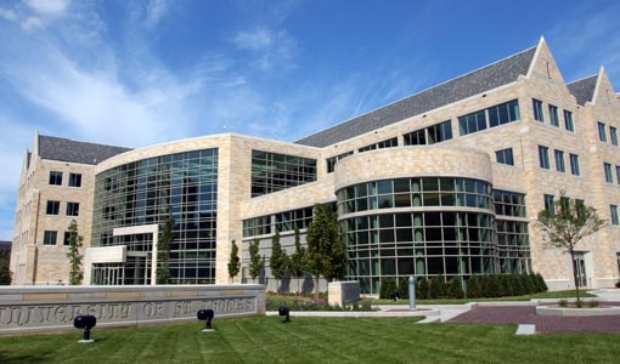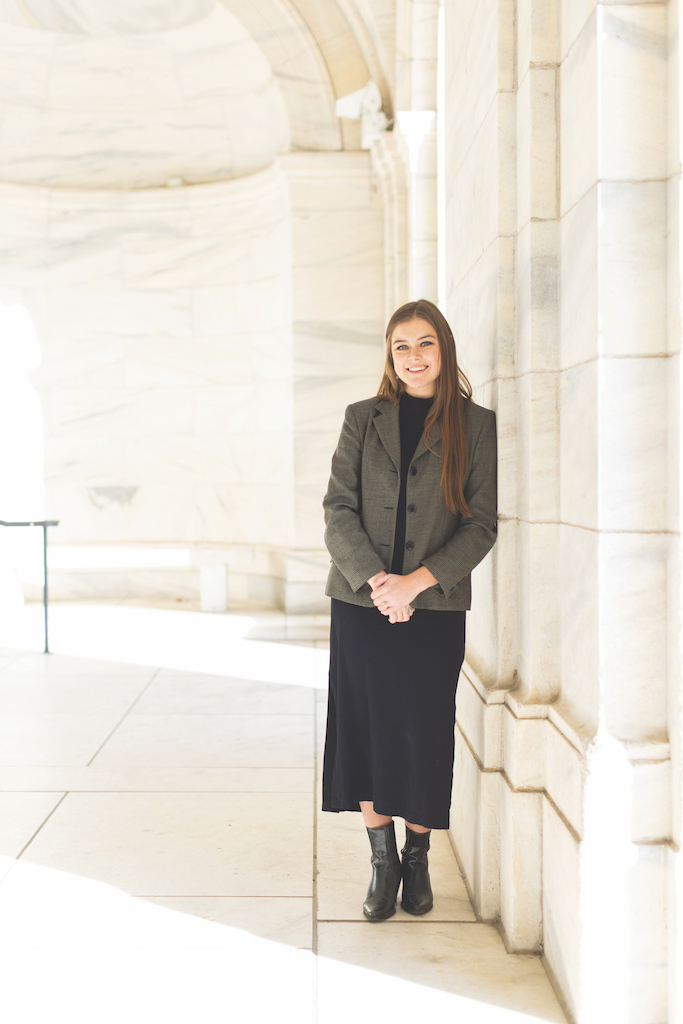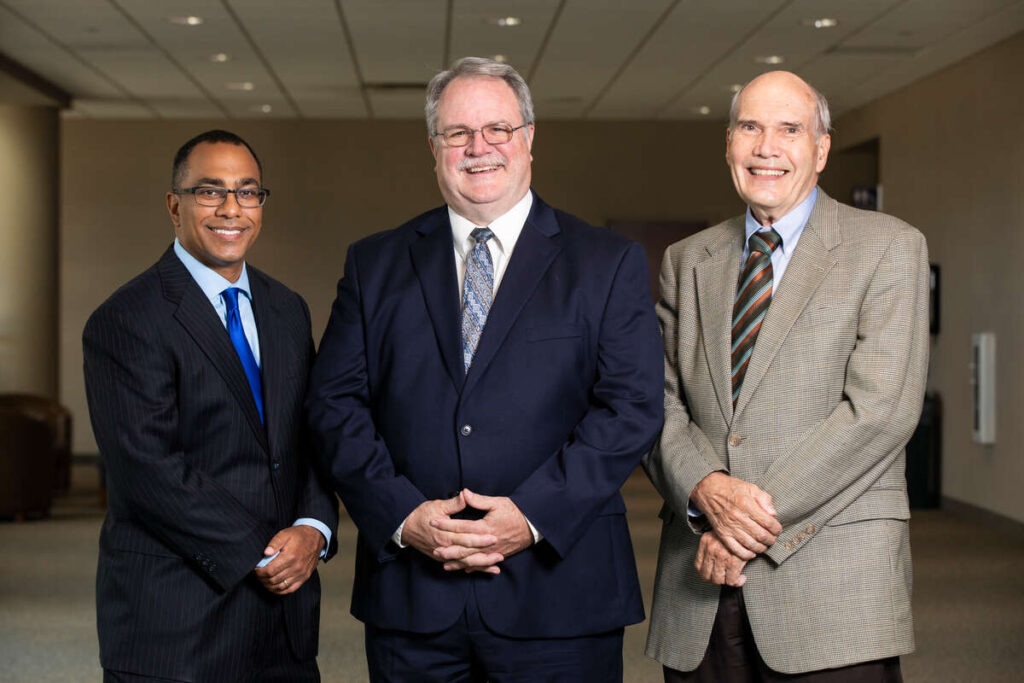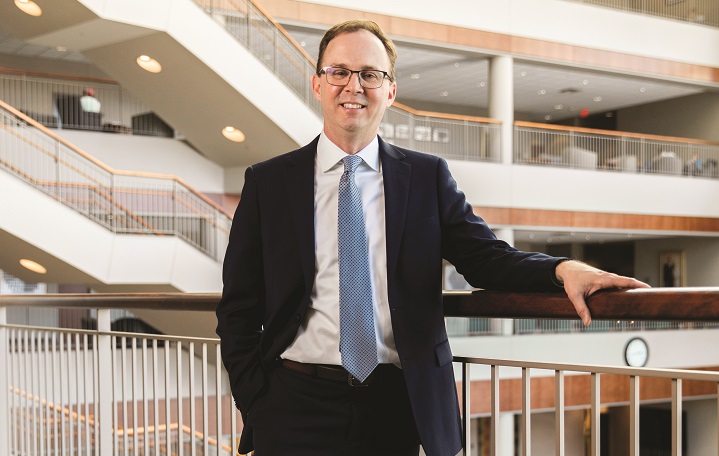From the beginning stages of planning and fundraising to the development of a strong mission statement and a bold standard of leadership for its faculty and students, the University of St. Thomas School of Law has become an archetypal leader in Catholic legal education in just 10 years.
The idea of a law school at St. Thomas was not new; a previous law school had been founded in 1923, but closed its doors only 10 years later in the midst of the financial tumult of the Great Depression. It was 57 years later that the university’s Board of Trustees would consider reopening the law school, and another decade before the school’s doors would open to its first class of 120 law students. Now, we look back on the first decade of the School of Law.
In the 1990s, the university commissioned a two-year feasibility study to determine potential need for a new law school (three already existed in theTwin Cities area), the costs involved in founding and supporting it, and the unique identity it would have. The study findings were favorable and in 1999, the Board of Trustees recommended that the university proceed with plans to rebuild and reopen St. Thomas’ School of Law. Father Dennis Dease, university president, explained the clear vision they had for the new law school: “Our two goals were to establish a law school rich in Catholic intellectual thought, with a strong moral tradition, and to build a school that is nationally ranked.”
The board’s decision to reopen the School of Law was the beginning of an enormous undertaking. First, it set a goal to raise $136 million to begin construction of the law school building and to recruit top-notch faculty. Judge Diana Murphy of the U.S. Court of Appeals for the 8th Circuit and vice chair of the law school’s Board of Governors believed in Dease’s vision. She led an ad hoc committee to explore the idea of a law school and discuss the prospect with university alumni. Murphy was “a natural fit as the spokesperson for the School of Law,” recalled Dease. Although the challenges were significant, the board soon realized there was strong community support for the university’s new endeavor. To date, the School of Law has raised $100 million of the $136 million goal.
With the solid foundation of community, alumni and donor support, the board sought to create an identity for the law school. In the beginning, it capitalized on the experience of David Link, former dean of the University of Notre Dame Law School and SisterSally Furay, R.S.C.J., former vice president and provost at the University of San Diego. Link collaborated with the board to create a mission statement that would be a stalwart underpinning of the law school’s intellectual and moral charge: University of St. Thomas School of Law, as a Catholic law school, is dedicated to integrating faith and reason in the search for truth through a focus on morality and social justice.
Furay provided her expertise on the numbers. Her guidance was invaluableon the funds required to operate a law school, the number of faculty members to hire and the number of students to admit. Other key players included professor Patrick Schiltz, who later was appointed a federal judge, and library director Edmund Edmonds. They helped assemble the law school faculty, administration and Board of Governors; establish temporary facilities; plan the school’s permanent home; recruit students; apply for accreditation from the American Bar Association; and raise additional funds as necessary.
In addition to providing exemplary administrative leadership, Schiltz worked to emphasize the significance of both faith and community at a Catholic law school. In his law journal article in 2004, he reflected on the significance of faith at a Catholic law school, restating his vision of a school that “would graduate lawyers who would integrate their religious and moral values into their professional identities and who would have a passion for using their legal training to serve God and their fellow human beings.” To do so, Schiltz suggested that the law school must create a meaningful community that brought together individuals “who care about each other and were willing to help each other with the hard work of discerning how to practice law in a way that honors one’s faith and values.”
Phenomenal Community Support
The university’s fundraising was a great accomplishment. The school has raised $100 million in gifts and pledges. With the simple, yet meaningful mission and clear intentions to keep class size relatively small, the Board of Trustees was able to garner support for a new Catholic law school. “The response of our alumni and friends has been remarkable,” Dease said. “It’s proof of their commitment to St. Thomas and their belief in what we will accomplish with the School of Law.” With this phenomenal community support, the law school was able to create one of the most beautiful law school buildings in the United States. The five-level, 158,000-square-foot building, was dedicated in 2003.
The building’s most prominent feature, the Schulze Grand Atrium, has four contiguous stories of south facing windows. The atrium serves as a gathering place for the school-wide Masses, the law journal’s bi-annual symposia, and events that bring local and national leaders and scholars to the law school.
Adjacent to Schulze Atrium, the Frey Moot Courtroom is a fully functioning courtroom. In addition to being a venue for moot court competitions and the trial advocacy classes, the school has used the courtroom to host the 8th Circuit Court of Appeals.
Other prominent features include the St. Thomas More Chapel, which seats 110 and spans two stories to prominently feature colored art glass windows and a 6-foot crucifix. A meditation room is situated directly above the chapel. The chapel and the meditation room provide a sanctuary space for students and community members to quietly reflect on their faith and to celebrate Mass.
Inspiring Leadership
The administration and faculty are responsible for the law school’s continued success. Dean Thomas Mengler arrived in 2002 from the University of Illinois where he was a professor and dean of the law school. Upon Mengler’s arrival, Dease commented, “He is a seasoned dean of one of the top 25 law schools in the United States, and he is enthusiastic about the faith-based mission of the St. Thomas law school. He will be a perfect fit here.” For nine years, he has proven this statement true by embracing the mission and encouraging students, faculty and staff to do the same.
When asked whether the law school has taken the path that he expected,Mengler responded as any law professor might: “yes, and no.” Using it as an example, he explained that the path was unknown, “the mission was distinctive and yet there was a lot of uncertainty. From the beginning, we have been exploring what it could be.” On the other hand, the mission has played the role that was expected of it, “because its core is to help students think about their purpose and vocation in life, about their role as a lawyer and leading an exemplary life.” In that role, the path has been clear.
Both Mengler and Dease credit the faculty and staff when discussing the law school’s success. “We were able to get the finest teachers and scholars in the legal community [who were] intensely mission driven,” Dease said. Mengler affirmed the sentiment explaining, “[the school] recruited a top 50 faculty. In all of the traditional ways, they are truly excellent. They have guided the school as teachers, as scholars nationally recognized in their fields and as role models to the students that they teach, both in the classroom and in the community.”
In addition to living the mission, faculty members have been recognized nationally for their academic contributions to the legal community. More than a third of the faculty members have been published in law journals of the top 25 law schools. St. Thomas ranked 38th nationally in law-review citations to tenured faculty and 12 tenured faculty members collectively have published 20 books, including major-academic-press books and casebooks from Aspen, West, Foundation and Carolina Academic Press.
Living the Mission
When asked for one word to describe the law school, Ryan Palmer immediately responded, “the mission.” As a member of the first graduating class, Palmer said that it was integral to his success in law school. “In the beginning, the mission provided great hopes for the faculty and students.” As it has developed, “the mission teaches students and encourages graduates to be more than technical lawyers but to dig deeper, to determine what is important to each individual client and to counsel and advise on how to best achieve their goals.” Each year, the School of Law awards students, faculty, staff, alumni and community members with Living the Mission Awards that recognize individuals for their exemplary service and contributions to the community in carrying out the mission.
Students have access to not only numerous but also deeply meaningful opportunities to “live the mission.” Enrolling in the Interprofessional Center for Counseling and Legal Services, attending lectures hosted by the Holloran Center for Ethical Leader ship in the Professions, and exceeding the public service requirements are just a few of the ways that students live the mission at St. Thomas.
While each law student must complete a minimum of 50 hours ofcommunity service prior to graduation, it is not uncommon for a student to complete more than double or triple that amount. Like the mission, the public service requirement attracts students with the inclination to serve the community. Many students attend St. Thomas to obtain a classic legal education in an environment where law is considered part of a bigger picture. “Students come seeking; they come to ask and reflect on the difficult questions of how to treat others with dignity and respect,” Mengler said.
Success Stories
Over the past 10 years, the law school has achieved many of its original goals. Enrollment is at 474 students and the school has 30 full-time faculty members. Fifty percent of the students come from states outside Minnesota. Alumni achievements in the community are multiplying. If asked about the success of UST Law graduates, Palmer points to Minnesota Lawyer and the notices in Bench & Bar and otherMinnesota State Bar Association publications. “I love opening Bench & Bar to see a fellow alumnus has been promoted and to read articles written by St. Thomas alumni.” In addition, the Alumni E-News highlights alumni accomplishments and links to articles or success stories that feature alumni.
Judge Murphy is quick to share how impressed she is with her law clerks who have graduated from St. Thomas’ School of Law. Over the past 10 years, three clerks have worked for Murphy, each serving a two-year term. The clerks have “held their own working alongside students from the top of their classes at Yale, Harvard, Berkeley and the University of Minnesota.” Murphy added of the St. Thomas students, “They have been excellent.”
From the beginning, the law school has been sensitive to concerns about whether the Twin Cities could support another law school. Dease reasoned that, “by keeping the class size small and drawing from a pool of out-of-state applicants, the law school has created its own niche.”
Other distinctive features are its community and alumni network. The strong and vital St. Thomas community not only built the law school, but continues to play a crucial role in its ongoing success. Students, faculty, staff and alumni have created an invaluable support network for graduates entering the legal profession. Along with his faith in the mission, Palmer insists that the sense of “community, camaraderie and support that students share with each other” makes St. Thomas truly unique. Creating positive (and lasting) relationships with his fellow classmates was easy for Palmer, and for that he credits the school’s environment: “It is absolutely a community of respect.”
Alumni support has been strong: St. Thomas has yet to identify another American Bar Association-accredited law school that has attained the same alumni participation in the last five years.
Among its accolades, The School of Law was ranked by The Princeton Review between first and fourth out of 172 law schools in the nation for “Best Quality of Life” among students (2006-2009). National Jurist ranked the School of Law No. 1 in the country for having the most externship placements per full-time student (2010), and listed the school seventh nationally for the percent of students who go into public interest law (2008).
One Unrealized Goal isWell Within Reach
One goal has yet to be accomplished the school has not achieved a top 100 national ranking. This is well within reach. All of the necessary componentsare in place. The community generously has provided financial support, the faculty is nationally recognized, graduates are making a positive impact on the legal community, and alumni support for the law school is at the top in the nation. And, St. Thomas is the archetype for law schools working a strong ethical component.
Given the law school’s history, it’s quite a coincidence that the school’s second founding would take place a decade prior to yet another great financial catastrophe. Yet, this time the law school is here for the long run. Alumni and donor support has stayed the course of rough economic times and continued to provide important and generous support for the school’s mission and values, a testament to the school’s most valued commodity: its community network. And most importantly, school administrators are confident in the value and quality of the education it provides its students.
Commenting on his original goal, “To establish a law school rich in Catholic intellectual thought, one with a strong moral tradition,” Dease stated, “we have more than exceeded.” He further explained that achieving the first goal is evidence that the law school is a success. “The reality is that the school is excelling and the rankings will catch up with that reality. It will only take time and there is no substitute for time.”
Read more from St. Thomas Lawyer





